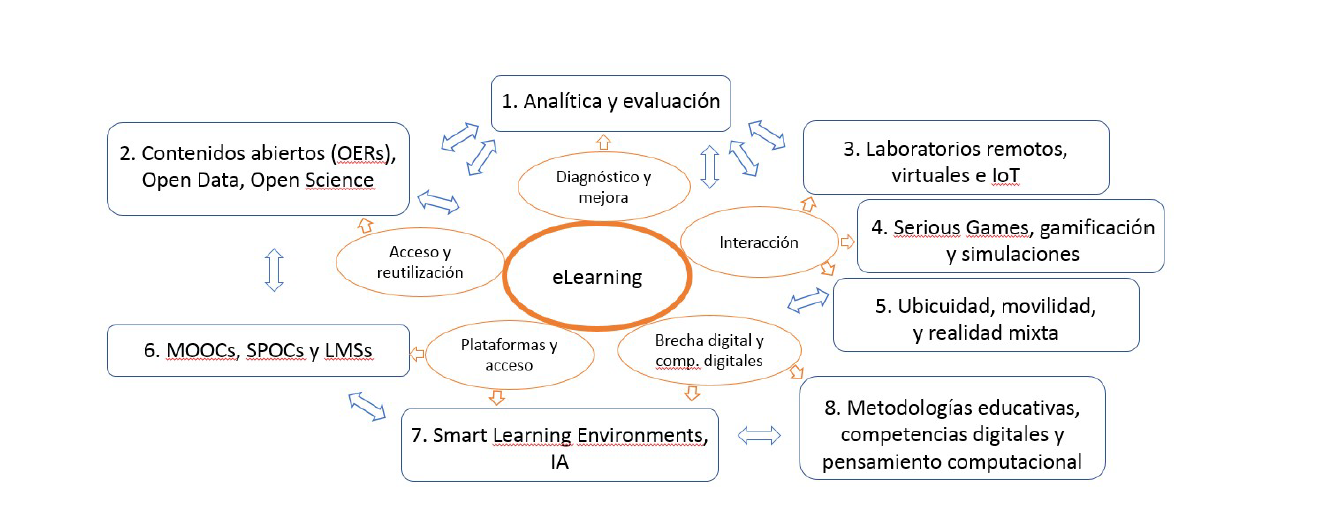Objectives
eMadrid project is divided in 8 lines of research, each of them with specific scientific and technical objectives. These lines of research are aligned with the topics of particular importance in the short and medium term in elearning that have been defined in many reports such as in the prestigious Horizon report series, and with the strategies set by the European Union through the initiative “Opening Up Education” and the Horizon 2020 program. The lines of research of eMadrid Network are as follows:
7. Smart Learning Environments, IA
Among the 10 proposed lines there is a high level of interdependence, as reflected in the image, which contributes to collaboration and synergies among members and associates of the project.

Description of the project objectives:
- Learning Analytics and Learning Evaluation. The need to advance in different aspects of calculating cognitive, meta-cognitive, personality or decision pattern indicators is observed if we analyze the indicators present in visualization panels (Schwendmann et al., 2017) or adaptive systems (Koedinger et al. al., 2015). In addition, it is important to study the requirements of your application in specific environments (e.g. serious games).
- Open Contents: OER, Open Data y Open Science. This research is aligned with the conclusions of the NMC Horizon Report Preview, 2018 Higher Education Edition prepared by the New Media Consortium (NMC) for the next 3-5 years.
- Remote and virtuals labs and IoT. This objective follows work on issues of acquiring practical skills in engineering and technical education at any level (from STEM in schools or institutes, universities or lifelong learning or for life) where they have shown that they are one of the emerging technologies in recent years, as can be seen in the indicators and trends in the use of technologies in education (Martin et al., 2018), in serious games and gamified environments, or in the use of remote laboratory systems and their management (Lowe et al ., 2016).
- Serious games, gamification and simulations. Once its effectiveness in certain domains has been demonstrated (Boyle, 2016), it is necessary to improve the processes of creation, maintenance and evaluation of these environments so that the barrier of entry can be reduced and its use can be generalized in other domains. The aspect of evaluating the effectiveness of games and gamification is especially complex and is closely related to learning analytics – objective 1- (Freire et al., 2016).
- Ubiquity, movility and mixed reality (AR/VR). Recent studies in the area (Bacca et al., 2014; Ibáñez et al., 2018) indicate the need to search for new educational metaphors that can take advantage of the ubiquity, mobility, interactivity and immersion facilities linked to augmented reality technology (AR ) and virtual reality (VR) in both formal and informal settings.
- MOOCs y SPOCs and LMSs. In relation to this objective, we find numerous studies (Dos Santos et al., 2016) that report that open education is already a reality, which makes it necessary to have open content and OER (objective 2) and that these and the courses Online mass or MOOCs are a habitual practice of any university institution (León-Urrutia et al., 2018). This reality opens up a wide range of methodological possibilities in the field of educational technologies (objective 8) and goes hand in hand with research in the area of learning analytics or Learning Analytics (objective 1).
- Smart learning environments, IA. The use of artificial intelligence techniques also contributes to expanding the aforementioned range, making it possible to adapt the content offered to students and the functionality of educational environments depending on the particular needs and contextual situation of each of them (Madhubala et el., 2017). In order to offer this personalized adaptation, it is necessary to extract information about each user in the least intrusive way possible, for which the use of natural language processing techniques is highly useful (Ortigosa et al., 2014).
- Educational methodologies, digital skills and computational thinking. This objective is transversal to the previous ones because the effective use of any educational technology requires adequate educational methodologies. The user’s point of view also arises in the workplace, where the effective use of computing requires that people have digital skills. The main framework used in the European Union to define digital competence is the DIGCOMP framework (Carretero, Vuorikari & Punie, 2017). As a result of this framework, there are more and more initiatives that show the need to acquire digital competence and computational thinking from an early age (SCIE and CODDII, 2018).

